The Intel Broadwell Xeon E3 v4 Review: 95W, 65W and 35W with eDRAM
by Ian Cutress on August 26, 2015 9:00 AM ESTOffice Performance
Dolphin Benchmark: link
Many emulators are often bound by single thread CPU performance, and general reports tended to suggest that Haswell provided a significant boost to emulator performance. This benchmark runs a Wii program that raytraces a complex 3D scene inside the Dolphin Wii emulator. Performance on this benchmark is a good proxy of the speed of Dolphin CPU emulation, which is an intensive single core task using most aspects of a CPU. Results are given in minutes, where the Wii itself scores 17.53 minutes.

Dolphin prefers single threaded speed and IPC, which the extra frequency of the v3 wins out here. The disparity between the 65W/95W v4 processors and the 35W processor is most obvious here.
WinRAR 5.0.1: link
Our WinRAR test from 2013 is updated to the latest version of WinRAR at the start of 2014. We compress a set of 2867 files across 320 folders totaling 1.52 GB in size – 95% of these files are small typical website files, and the rest (90% of the size) are small 30 second 720p videos.
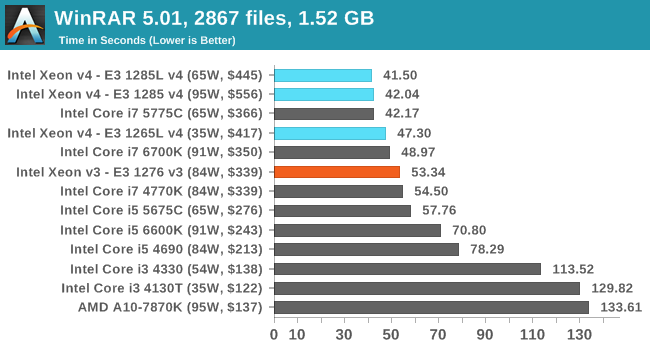
WinRAR is our classic 'eDRAM works here!' benchmark, clearly showing how Broadwell benefits. Although, one might argue that WinRAR is not a typical workload environment. It is also poignant to show that the 95W v4 doesn't win here in this variable-threaded load.
3D Particle Movement
3DPM is a self-penned benchmark, taking basic 3D movement algorithms used in Brownian Motion simulations and testing them for speed. High floating point performance, MHz and IPC wins in the single thread version, whereas the multithread version has to handle the threads and loves more cores.
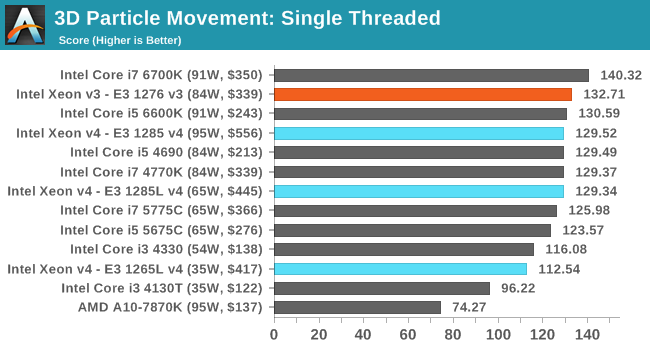

Similar to CineBench, in single threaded mode the v3 wins out due to the faster frequency, but in multithreaded mode the advancements in the Broadwell core due to better thread resource management puts at least the 95W v4 ahead.
FastStone Image Viewer 4.9
FastStone is the program I use to perform quick or bulk actions on images, such as resizing, adjusting for color and cropping. In our test we take a series of 170 images in various sizes and formats and convert them all into 640x480 .gif files, maintaining the aspect ratio. FastStone does not use multithreading for this test, and results are given in seconds.
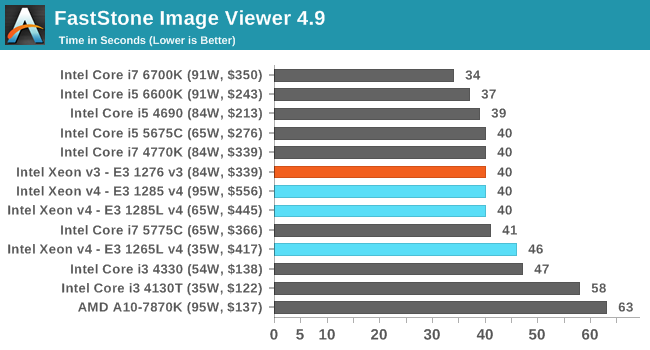
Web Benchmarks
On the lower end processors, general usability is a big factor of experience, especially as we move into the HTML5 era of web browsing. For our web benchmarks, we take four well known tests with Chrome 35 as a consistent browser.
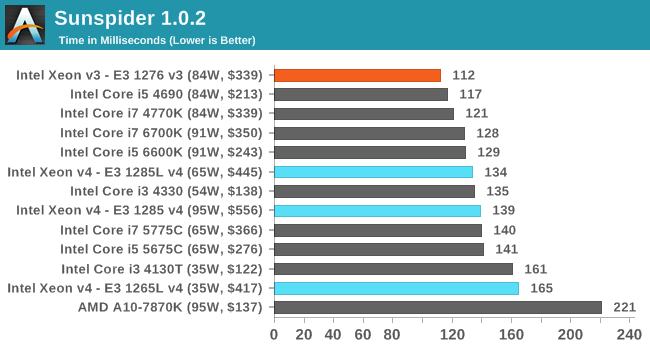
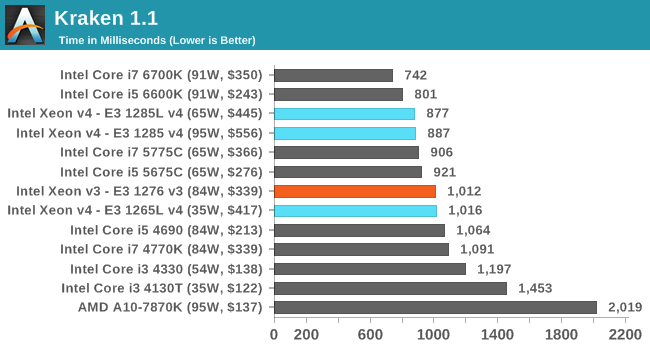
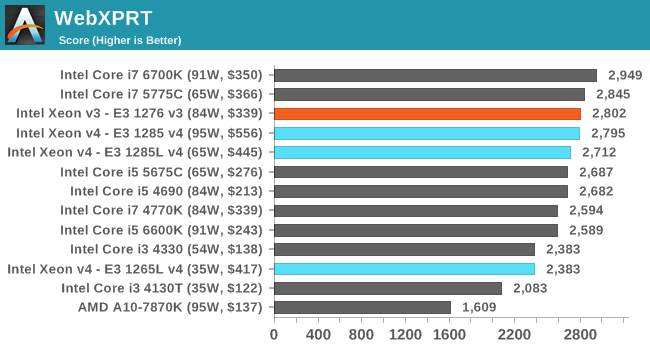
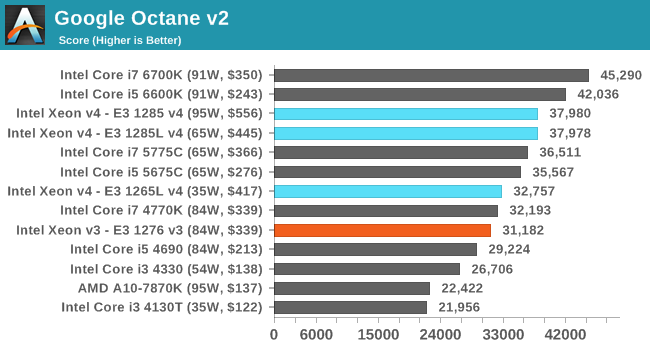
For web implementations, both Kraken and Octane see benefits moving up to Broadwell, but it is worth noting that moving to Skylake is an even better benefit. This again comes down to the management of CPU instructions between threads, and having benefits associated with keeping the knowledge of past instructions or information in lower cache levels. In would seem in this regard, if you count these benchmarks indicative of a real workload, that web-based throughput implementations are more in-flight operation limited than any other resource.










72 Comments
View All Comments
Ian Cutress - Thursday, August 27, 2015 - link
So to clear up your misconceptions: we (or more specifically, I) have not retested any AM3 product yet on our 2015 benchmark suite due to time restrictions and general lack of reader interest in AM3. I have 3 test beds, and our CPU/GPU tests are only partially automated, requiring 35+ working hours of active monitoring for results. (Yes, can leave some tests on overnight, but not that many). Reserving one test bed for a month a year for AM3+ limits the ability to do other things, such as motherboard tests/DRAM reviews/DX12 testing and so on.You'll notice our FX-9590 review occurred many, many months after it was officially 'released', due to consumer availability. And that was just over 12 months ago - I have not been in a position to retest AM3 since then. However, had AMD launched a new CPU for it, then I would have specifically made time to circle back around - for example I currently have the A8-7670K in to test, so chances are I'll rerun the FM2+ socket as much as possible in September.
That being said, we discussed with AMD about DirectX 12 testing recently. Specifically when more (full/non-beta) titles are launched to the public, and we update our game tests (on CPU reviews) for 2016. You will most likely see the FX range of CPUs being updated in our database at that time. Between now and then, we have some overlap between the FX processors and these E3 processors in our benchmarking database. This is free for anyone to access at any time as and when we test these products. Note that there is a large price difference, a large TDP difference, but there are some minor result comparisons for you. Here's a link for the lazy:
http://anandtech.com/bench/product/1289?vs=1538
The FX-9590 beats the 35W v4 Xeon in CineBench, POV-Ray and Hybrid, despite being 1/3 the price but 6x the power consumption.
Oxford Guy - Thursday, August 27, 2015 - link
The 9590 is a specialty product, hardly what I was focusing on which is FX overclocked to a reasonable level of power consumption. The 9590 does not fall into that category.You can get an 8320E for around $100 at Microcenter and pair it with a discount 970 motherboard like I did ($25 with the bundle pricing a few months ago for the UD3P 2.0) and get a decent clockspeed out of it for now much money. I got my Zalman cooler for $20 via slickdeals and then got two 140mm fans for it. The system runs comfortably at 4.5 GHz (4.4 - 4.5 are considered the standard for FX -- for the point where performance per watt is still reasonable). Those pairing it with an EVO cooler might want 4.3 GHz or so.
The 9590 requires an expensive motherboard, expensive (or loud) case cooling, and an expensive heatsink. Running an FX at a clockspeed that is below the threshold at which the chip begins to become a power hog is generally much more advisable. And, review sites that aren't careful will run into throttling from VRMs or heat around the chip which will give a false picture of the performance. People in one forum said adamantly that the 9590 chips tend to be leaky so their power consumption is even higher than a low-leakage chip like 8370E.
One of your reviews (Broadwell I think) had like 8 APUs in it and not a single FX. That gives people the impression that APUs are the strongest competition AMD has. Since that's not true it gives people the impression that this site is trying to manipulate readers into thinking Intel is more superior than it actually is in terms of price-performance.
There is no doubt that FX is old and was not ideal for typical desktop workloads when it came out. Even today it only has about 1.2 billion transistors and still has 32nm power consumption. But, since games are finally beginning to use more than two cores or so, and because programs like Blender (which you probably should use in your results) can leverage those cores without exaggerating the importance of FPU (as Cinebench is said to do) it seems to still be clinging to relevance. As for lack of reader interest in FX, it's hard to gauge that when your articles don't include results from even one FX chip.
Regardless of reader interest if you're going to include AMD at all, which you should, you should use their best-performing chip (although not the power-nuts 9590) design — not APUs — unless you're specifically targeting small form factors or integrated graphics comparisons.
Oxford Guy - Thursday, August 27, 2015 - link
You also ran an article about the 8320E. Why not use that 8320E, overclocked to reasonably level like 4.5 GHz, as the basis for benchmarks you can include in reviews?SuperVeloce - Thursday, August 27, 2015 - link
Clocks are not identical (you know the meaning of that word, right?). And the 4790k was released a year after first haswells. Usually you compare models from the launch day of the said arhitecture.MrSpadge - Thursday, August 27, 2015 - link
It doesn't matter what launched on launch day of the older competition. It matters what one can buy at the current launch date instead of the new product.mapesdhs - Thursday, August 27, 2015 - link
Hear hear! Reminds me of the way reference GPUs keep being used in gfx articles, even when anyone with half a clue would buy an oc'd card either because they're cheaper, or seller sites don't sell reference cards anymore anyway.Oxford Guy - Wednesday, August 26, 2015 - link
"cue the realists"Corporations are a conspiracy to make profit for shareholders, CEOs, etc. The assumption of conspiracy should be a given, not a "theory". Any business that isn't constantly conspiring to deliver the least product for the most return is going to either die or stagnate.
boxof - Wednesday, August 26, 2015 - link
"In a recent external podcast, David Kanter"Couldn't bring yourselves to mention your competition huh? Stay classy.
Dr.Neale - Wednesday, August 26, 2015 - link
Your comparison of the Xeon e3-1276 v3 to the e3-1285 v4, e3-1285L v4, and e3-1265L v4 is systematically slightly biased in favor of the e3-1276 v3, because for all tests you use (non-ECC) DDR3 1866 memory, whereas with ECC memory (and a C226 chipset that supports it, as in an ASUS P9D WS motherboard), the v3 Xeon is limited to DDR3 1600, while the v4 Xeons can use DDR3 1866 memory.Therefore using DDR3 1866 memory with the v3 Xeon gives it a slight systematic performance boost over what it would achieve with only DDR3 1600 memory, which is the maximum speed it can use in an ECC / C226 workstation.
With this in mind, I believe the performance of a e3-1276 v3 Xeon with DDR3 1600 memory would more closely match that of the e3-1285 v4 and e3-1285L Xeons with DDR3 1866 memory, than is indicated in the graphs here, where the v3 and v4 Xeons are all tested with the same DDR3 1866 memory only.
ruthan - Thursday, August 27, 2015 - link
This power consumption mystery have to be discovered, its like Geforce 970 4 GB thing. Maybe Intel cheating with those numbers, because there are customer like me, which prefer lower power and silence are ready to pay for that.Most typical workstation use case, where im still missing tons of horsepower on CPU side is virtualization, especialy for gaming, yesterday released Vmware workstation 12 with DX10 support. Especially in Linux enviroment, gaming in virtual machine make a sense (i know, i know there is not DX10 suportt even through wrapper).